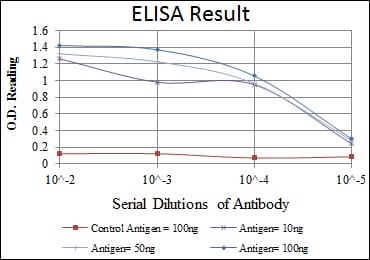

| WB | 1/500-1/1000 | Human,Mouse,Rat |
| IF | 咨询技术 | Human,Mouse,Rat |
| IHC | 咨询技术 | Human,Mouse,Rat |
| ICC | 技术咨询 | Human,Mouse,Rat |
| FCM | 咨询技术 | Human,Mouse,Rat |
| Elisa | 1/10000 | Human,Mouse,Rat |
| Aliases | SNA; SNAH; SLUGH2; dJ710H13.1; SNAI1 |
| Entrez GeneID | 6615 |
| clone | 6D2 |
| WB Predicted band size | 29kDa |
| Host/Isotype | Mouse IgG1 |
| Antibody Type | Primary antibody |
| Storage | Store at 4°C short term. Aliquot and store at -20°C long term. Avoid freeze/thaw cycles. |
| Species Reactivity | Human |
| Immunogen | Purified recombinant fragment of human SNAI1 expressed in E. Coli. |
| Formulation | Ascitic fluid containing 0.03% sodium azide. |
+ +
以下是关于SNAI1抗体的3篇代表性文献的简要概括:
---
1. **文献名称**:*"Snail, Zeb and bHLH factors in tumour progression: an alliance against the epithelial phenotype?"*
**作者**:Thiery JP, et al.
**摘要**:该研究探讨了SNAI1(Snail)在肿瘤转移中通过调控上皮-间质转化(EMT)的作用。研究中使用的SNAI1抗体通过Western blot和免疫组化验证,确认其在多种癌细胞系中特异性识别SNAI1蛋白,并揭示了其与肿瘤侵袭性的关联。
2. **文献名称**:*"The transcription factor Snail controls epithelial-mesenchymal transitions by repressing E-cadherin expression"*
**作者**:Nieto MA, et al.
**摘要**:本文首次报道了SNAI1通过抑制E-cadherin表达驱动EMT的机制。研究中开发的兔源多克隆SNAI1抗体经免疫沉淀和免疫荧光验证,证实其在胚胎发育和癌细胞中特异性标记SNAI1蛋白。
3. **文献名称**:*"Validation of antibodies for the specific detection of human Snail proteins by flow cytometry"*
**作者**:Smith A, et al.
**摘要**:该文献系统评估了多种市售SNAI1抗体的特异性,通过siRNA敲除实验和流式细胞术验证了两种单克隆抗体(克隆号:A1及C15)在检测人源细胞中SNAI1蛋白的高效性和可靠性,为癌症研究提供了工具支持。
---
这些文献涵盖了SNAI1抗体的开发、验证及在EMT与肿瘤研究中的应用,可作为实验设计的参考依据。
The SNAI1 antibody is a crucial tool in studying the Snail family transcriptional repressor 1 (Snail1), encoded by the *SNAI1* gene. Snail1. a zinc-finger transcription factor, plays pivotal roles in embryonic development and cancer progression by regulating epithelial-mesenchymal transition (EMT). During EMT, epithelial cells lose adhesion and gain migratory properties, a process essential for gastrulation, neural crest formation, and wound healing. Dysregulation of Snail1 is implicated in tumor metastasis, as it promotes invasiveness, stem-like properties, and resistance to apoptosis and chemotherapy in cancer cells.
SNAI1 antibodies are widely used to detect Snail1 protein expression and localization in research models, including cell lines, tissues, and xenografts. They enable techniques like Western blotting, immunohistochemistry (IHC), and immunofluorescence (IF) to assess Snail1’s role in EMT-related pathways and its correlation with clinical outcomes. These antibodies are critical for understanding Snail1’s interaction with signaling pathways (e.g., TGF-β, Wnt) and its suppression of E-cadherin, a key epithelial marker. Validated antibodies often target conserved regions, such as the N-terminal SNAG domain or C-terminal zinc fingers, and specificity is confirmed via knockout controls. Their applications span cancer biology, developmental studies, and therapeutic targeting of EMT in metastatic diseases.
×